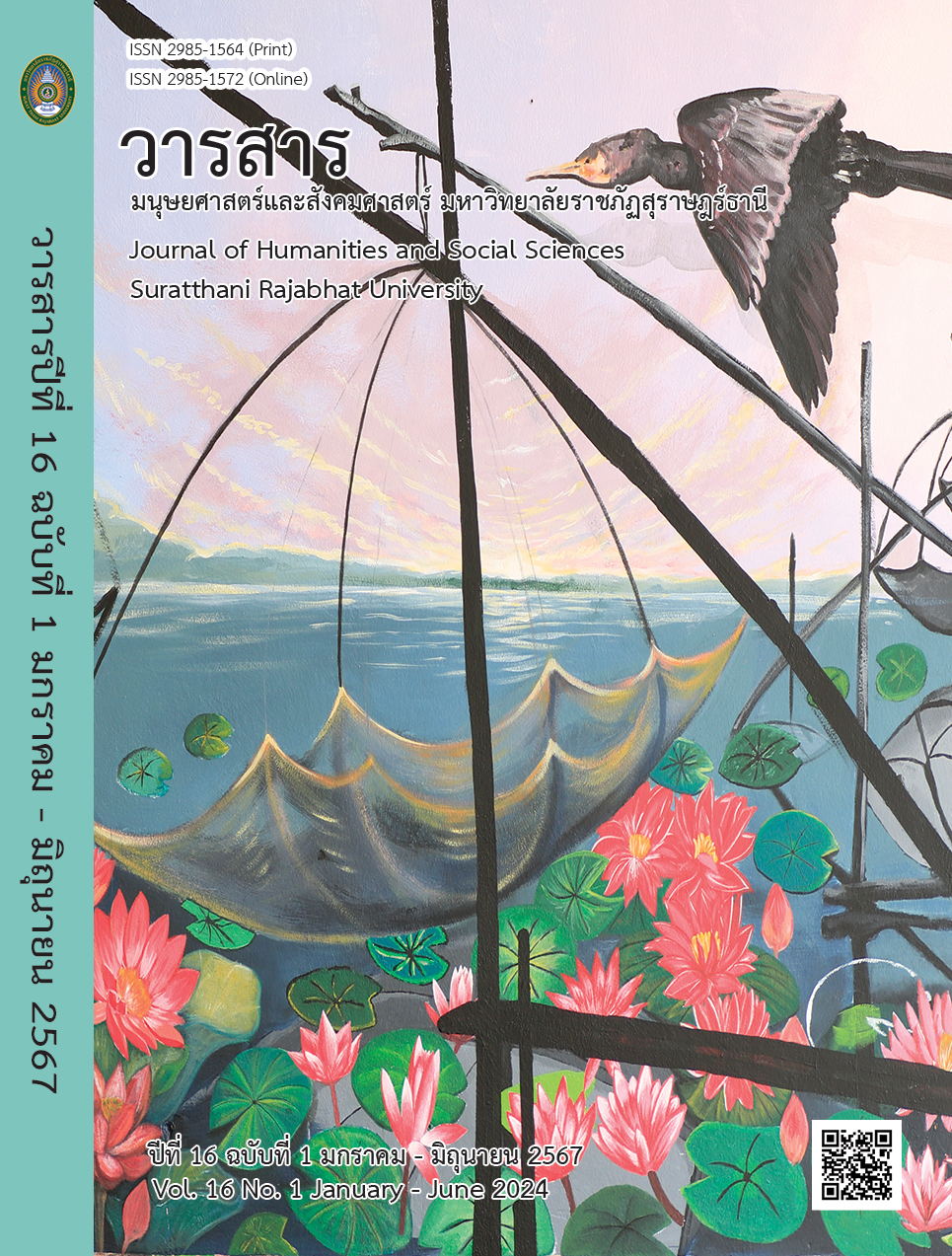The Identity of the City Encomium: Writing Techniques and Reflection of Contemporary Society in Eulogistic Literature of King Rama IX’s Reign
Main Article Content
Abstract
The objectives of this article were to 1) examine the authorization strategies of the City Encomium in Eulogistic Literature of King Rama IX’s Reign and 2) investigate the identity of the Reflection of Contemporary
Society in the City Encomium in Eulogistic Literature of King Rama IX’s Reign. The study collected data from eight stories of the City Encomium in the Eulogistic Literature of His Majesty King Bhumibol Adulyadej the Great,
utilizing established documents and conducting an in-depth interview with the poet who created the work using descriptive and analytical methods.
The results demonstrated that King Rama IX's eulogistic literature authorized the City Encomium through traditional literary techniques such as versification and the arts of literature. The strategies utilized to author the City Encomium magnificently involved poetical voice, meaning, and imagery, and 2) the reflection of contemporary society in the City Encomium in the eulogistic literature of King Rama IX's Reign. King Rama IX uniquely created the City Encomium; the traditional authorization reflected a contemporary perspective throughout the content presentation, accurately portraying the country's state during his reign. The globalization era significantly shaped and developed city imagery. A nation's civilization was as progressive as
developed countries, including the aesthetic palaces and castles and the traditional literature in the prospering cities. It indicated King Rama IX's
intelligence in ruling the nation prosperously. Furthermore, research
revealed that the "city" appearance in the City Encomium of King Rama IX's Reign serves the following functions: 1) a mainstream historical record and 2) a model for later literary compositions. This knowledge will be helpful in further developing research in Thai literature.
Article Details

This work is licensed under a Creative Commons Attribution-NonCommercial-NoDerivatives 4.0 International License.
All published manuscripts have been verified by peer-peer professors in the fields of humanities and social sciences. Reprinting of the article must be authorized by the editorial staff.
References
กาญจนา นาคสกุล. (2552). ภาษาไทย: ชุดคำไทย. กรุงเทพฯ: สมาคมครูภาษาไทยแห่ง
ประเทศไทย.
จิรภา อ่อนเรือง. (2514). ลิลิตราชาภิเษกสมรสบรมราชาภิเษก และเฉลิมพระราชมณเฑียร
พระบาทสมเด็จพระปรมินทรมหาภูมิพลอดุลยเดช. พระนคร: นวจันทร์
และเทพธานีกรีฑา.
ฉลาดชาย รมิตานนท์. (2545). แนวคิดในการศึกษาอัตลักษณ์ความเป็น “ไท”. ใน สรัสวดี
อ๋องสกุล และโยชิยูกิ มาซูฮารา (บ.ก.), การศึกษาประวัติศาสตร์และวรรณกรรม
ของกลุ่มชาติพันธุ์ไท, (น.153-175). กรุงเทพฯ: อมรินทร์พริ้นติ้งแอนด์พับลิชชิ่ง.
ดุสิต คร่ำสุข, พระมหา. (2532). 60 พระพรรษามหาราชคำฉันท์. กรุงเทพฯ: มูลนิธิ
ธนาคารกรุงเทพฯ.
ธเนศ เวศ์ภาดา. (2549). หอมโลกวรรณศิลป์: การสร้างรสสุนทรีย์แห่งวรรณคดีไทย.
กรุงเทพฯ: ปาเจรา.
ปัทมา ฑีฆประเสริฐกุล. (2556). ยวนพ่ายโคลงดั้น: ความสำคัญที่มีต่อการสร้างขนบและ
พัฒนาการของวรรณคดีประเภทยอพระเกียรติของไทย. วิทยานิพนธ์ อ.ด.
(ภาษาไทย). กรุงเทพฯ: จุฬาลงกรณ์มหาวิทยาลัย.
มะเนาะ ยูเด็น, และ วันเนาว์ ยูเด็น. (2548). ความรู้เกี่ยวกับร้อยกรอง. กรุงเทพฯ: องค์การ
ค้าของคุรุสภา.
ราชบัณฑิตยสถาน. (2556). พจนานุกรม ฉบับราชบัณฑิตยสถาน พ.ศ. 2554 (พิมพ์ครั้งที่
. กรุงเทพฯ: นานมีบุ๊คส์พับลิเคชั่นส์.
วงศ์ เชาวนะกวี. (2530). บทกวีเฉลิมพระเกียรติพระบาทสมเด็จพระเจ้าอยู่หัวภูมิพลอดุลยเดช.
กรุงเทพฯ: ธนาคารไทยพาณิชย์.
วทัญญู ปรัชญานนท์. (2539). 50 ฤดูฝน. กรุงเทพฯ: ปูนซิเมนต์ไทย.
วรรณคดี สรรพจิต. (2525). บารมีพระร่มเกล้า: คำฉันท์เฉลิมพระเกียรติพระบาทสมเด็จ
พระปรมินทรมหาภูมิพลอดุลยเดชมหาราช ฉบับชนะการประกวด. กรุงเทพฯ:
กรมศิลปากร.
วราภรณ์ บำรุงกุล. (2537). ร้อยกรอง. กรุงเทพฯ: ต้นอ้อ.
ศิวกานท์ ปทุมสูติ. (2539). สมเด็จพระภัทรมหาราชคำฉันท์. กรุงเทพฯ: ต้นอ้อแกรมมี่.
เศรษฐ พลอินทร์. (2524). ลักษณะคำประพันธ์ไทย. กรุงเทพฯ: ภาคพัฒนาตำราและ
เอกสารวิชาการ หน่วยศึกษานิเทศก์ กรมการฝึกหัดครู.
สมหวัง สาระภะ, พระมหา. (2531). พระราชกรณียกิจ: คำกลอนเฉลิมพระเกียรติพระบาท
สมเด็จพระปรมินทรมหาภูมิพลอดุลยเดช ฉบับชนะประกวด. กรุงเทพฯ: กอง
วรรณคดีและประวัติศาสตร์ กรมศิลปากร.
เสาวณิต วิงวอน. (2530). การศึกษาวิเคราะห์วรรณกรรมยอพระเกียรติ. วิทยานิพนธ์ อ.ด.
(ภาษาไทย). กรุงเทพฯ: จุฬาลงกรณ์มหาวิทยาลัย.
อรอนงค์ ตั้งก่อเกียรติ. (2542). ลิลิตอัครศิลปิน (พิมพ์ครั้งที่ 3). กรุงเทพฯ: ต้นอ้อ 1999.
Benson, C.D. (2009). The Dead and the Living: Some Medieval Descriptions
of the Ruins and Relics of Rome Known to the English in Albrecht
Classen (ed.), Urban Space in the Middle Ages and the Early Modern
Age, (pp. 147–182). Berlin: Walter de Gruyter.
Parks, M.H. (2008). City of Praise: The Politics of Encomium in Classical
Athens. Ph.D. (Providence). Providence: Brown University.
Ruth, J.S. (2002). The City Encomium in Medieval and Humanist Spain.
Ph.D.(Hispanic & Luso-Brazilian Literatures & Languages). New York:
The City University of New York.
Vardic, Z.P. (2017). Laudes civitatum: Filip de Diversi's ″Description of the
Position of Buildings, the Governance and the Praiseworthy
Customs of the Glorious City of Dubrovnik in Latin, I.B.& Vardic, Z.P.
(ed.), TOWNS AND CITIES OF THE CROATIAN MIDDLE AGES Image of
the Town in the Narrative Sources: Reality and/or Fiction? , (pp. 269-
. Zagreb: Croatiian Institute of History.
บุคลานุกรม
ดุสิต คร่ำสุข (ผู้ให้สัมภาษณ์) วิเชษฐชาย กมลสัจจะ (ผู้สัมภาษณ์). ณ 999/23 หมู่บ้าน
วิลล่าพาร์ค หมู่ 11 ตำบลหัวทะเล อำเภอเมือง จังหวัดนครราชสีมา. เมื่อ
วันที่ 17 ตุลาคม 2565.
ศิวกานท์ ปทุมสูติ (ผู้ให้สัมภาษณ์) วิเชษฐชาย กมลสัจจะ (ผู้สัมภาษณ์). ณ ศูนย์เรียนรู้ทุ่ง
สักอาศรม 35 หมู่ 13 ตำบลจรเข้สามพัน อำเภออู่ทอง จังหวัดสุพรรณบุรี.
เมื่อวันที่ 1 สิงหาคม 2565.
อรอนงค์ ตั้งก่อเกียรติ (ผู้ให้สัมภาษณ์) วิเชษฐชาย กมลสัจจะ (ผู้สัมภาษณ์). ณ 187/220
หมู่บ้านอยู่สุข 2 ซอยสรงประภา 24 แขวงสีกัน เขตดอนเมือง กรุงเทพมหานคร.
เมื่อวันที่ 1 พฤษภาคม 2565.


